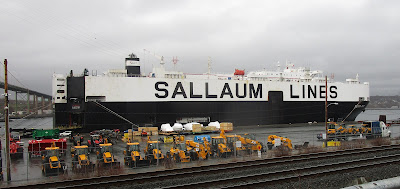The name Atlantic Star has no doubt been carried on the bows of many ships over the years [see footnote]. In my mind however there are two that stand out. Atlantic Container Line's current Atlantic Star is always impressive. Sailing this evening April 23 for New York on the westbound leg of its regular transatlantic run it caught a few of the last rays of the setting sun.
Built in 2015 by Hudong-Zhonghua in Shanghai, the 100,430 gt, 55.649 dwt ship was the first of the 4th generation ACL ships. Along with its four sister ships,
Atlantic Sail, Sea, Sky and
Sun, they are the largest ConRo ships in the world. They maintain the weekly service, usually calling in Halifax eastbound and westbound, carrying a variety of containers and RoRo cargo.
One interesing aspect of that cargo is a regular traffic of European recreational vehicles (seasonally) usually German and Swiss. Until the COVID era the owners of these vehicles had the option of travelling on the same ship and on arrival in Halifax (or a US port) could start their North American tour right from the terminal.
Many of the European recreational vehicles are set up as expedition vehicles, capable of traversing rough terrain. I don't know how comfortable they are on the road, but they are largely self-contained. (See recent Truckfax posts for more on this topic.) Due to health concerns ACL is not accepting passengers for the time being, but they may resume the service later this year. (The ships could carry a limited number of "pedestrian" passsengers too.) ACL is still carrying the vehicles, and there are usually a few on each trip at this time of the year. The owners have to find their own way to Halifax.
The current Atlantic Star is the second ACL ship to carry the name. The first was one of the original "S" class First Generation ACL ships. With Atlantic Saga, Song and Span (later renamed Service) they were among the pioneering ConRos. Atlantic Star (i) was built in 1967 by Atelier et Chantier de Dunkerque/Bordeaux (France-Gironde) in Dunkirk and measured 11,839 gt, 18,500 dwt. Its massive (for the time) 20,700 bhp MAN engine could drive the ship at 21 knots.
In 1976 the ship was lengthened 16m (four cellular holds, installed forward of the car decks) at Hitachi Zosen, Innoshima and sponsons were added to strengthen the hull, resulting in revised tonnages of 15.055 gt, 20,346 dwt. The three doors on each side were also eliminated.
The container capacity of 501 TEU, was thus increased to 1154 TEU. The ship soldiered on for another nine years until sold for scrap.
Atlantic Star arrived in Kaohsiung December 14, 1987 and was broken up.
The first Atlantic Star was the first RoRo service ship to call in Halifax - even before there was a container pier, March 30, 1970. It carried 200 finished Volvo cars destined for the US and 200 knocked-down kits, for assembly in Halifax. In those days it was accomodated at Pier 36 where a ramp had been built into the pier face.
The side doors are visible in the above photo. They were never used in Halifax as far as I know.The first Atlantic Star was built for Holland-America Line, one of the founding partners of ACL. It later transferred to Cunard as ownership in ACL was consolidated. The line is now owned by the Grimaldi Group.
The Pier 36 ramp will soon be history as the area will be filled in to provide more backup land for the Southend Terminal operated by PSA Halifax.
Footnote
Another Atlantic Star of a far different size was, surprisingly, also from the Netherlands. Built in 1964 by Nieuwe Noord Nederlandse Schps., Groningen, it was a 499 gt, 975 dwt general cargo / reefer.
Owners were the well known reefer operators Dammers + van der Heide Shipping and Trading Co Ltd., also of Groningen. However between 1964 and 1973 the Halifax company Shaw Steamship Co Ltd chartered the ship for their Caribbean service. It maintained a regular trade of general freight, including salt fish, southbound, with whatever offered north bound (Jamaican rum being a favourite).
In the photos above the ship is docked at Pier 34 - raising the possibility that both Atlantic Stars from Rotterdam were in port at adjacent berths at the same time. I have no record of this happening. This is the area that will be filled in.
When the Shaw SS service was wound up the ship was sold and over the ensuing years had nine different names, latterly in the Honduran registry. It took its last name of Tarigtiq in 1997. Lloyd's Register dropped its listing in 2012 with the notation "existence in doubt".
.


.JPG)
.JPG)
.JPG)




















.JPG)





.JPG)



















